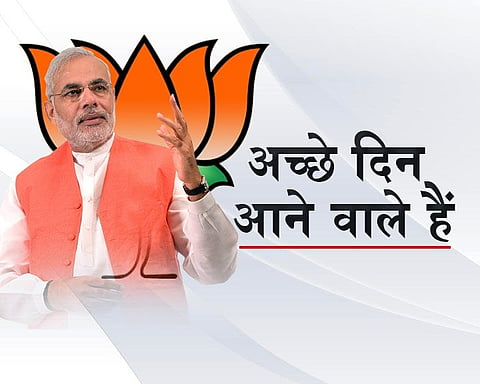
- Home
- Live Blog
- Breaking News
- Top Headlines
- Cities
- NE News
- Sentinel Media
- Sports
- Education
- Jobs

New Delhi, May 24: There’s only one year more to go for the BJP-led regime before another test at the hustings. But is the country any nearer to Prime Minister Narendra Modi’s promised ‘acche din’ (good days)? Four years ago, the country had voted the present regime to power on hopes of better days in all socio-economic-political spheres. But despite some strong structural reforms like GST, and gut-wrenching changes like demonetisation, the jury may still be out on how good it has been, according to economists and others experts.
Despite India’s GDP growth of 7.2 per cent in the third quarter (October-December) of 2017-18, some economists feel that the demonetisation drive, avowedly taken to “cleanse the system” of black money, had ended up damaging the country’s economy instead. “Demonetisation was a terrible mistake by the government, for which the common people paid the price. It has reduced people’s trust in the banking system, as they were denied their own money during the period of cash crunch. It takes so much time and work to build institutions and policies — it is so much easier and faster to break things,” Jayati Ghosh, Economics Professor at Jawaharlal Nehru University (JNU), told IANS.
The government decided to ban 1,000 rupee and 500-rupee notes on November 8, 2016, taking away 86 per cent of the total currency in circulation. “May be this move had served the government’s purpose politically, but economically it was a bad one,” Ghosh added.
After demonetisation, credit off-take in the country declined sharply. “Between November-December 2016, it was at historic low of 60 years. Investment into the country also took a big hit,” he said. However, Ranen Banerjee, Partner & Leader, Public Finance and Economics, at PricewaterhouseCoopers (PwC) has a different take on some of the benefits flowing from the action.
“Demonetisation had positive impact as far as digital payments were concerned. It shot up sharply during that period but came down subsequently. The level is still higher earlier. But demonetisation as a measure did not deliver all the results that it was supposed to deliver,” Banerjee said.
The government’s other major thrust, though, on Goods and Services Tax (GST) — rolled out on July 1 last year, got better billing. Economists are hopeful that it will bring in beneficial changes once the hiccups are over. Banerjee says GST would change the entire landscape of tax compliance in the country by creating a multiplier effect. “GST was a bold move which is showing positive results,” he added.
Ghosh, though, thinks GST goes against the grain of federalism. “A unified system is not so necessary in a federal structure — for example, the US does not have it and still has a very modern economy. In a federal structure you have to allow states to have some money raising power. Further, GST implementation has been really bad.”
“The government’s mission-mode development campaigns have delivered notable results, adding to overall growth multipliers. The firm level and sectoral level numbers look promising for the next year in terms of orders booked and capacity utilisation,” said CII’s Banerjee. Former economics professor at Indian Statistical Institute, Dipankar Dasgupta, who holds that the economy was yet to recover from the hit it took because of demonetisation, says that on GST he was hopeful that with time it will stabilise. “In the other countries where it was introduced there were teething problems too,” he said. (IANS)